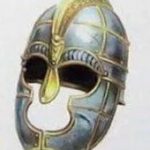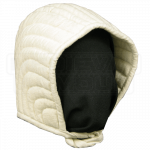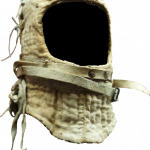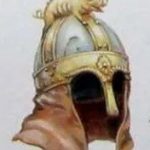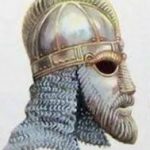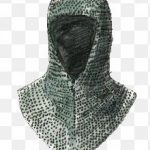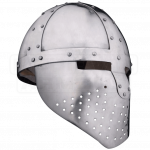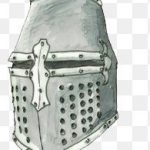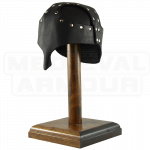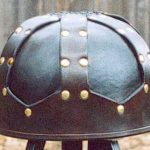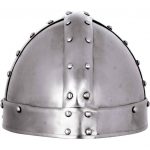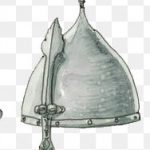(^Click here for the second part of the Shields List^)
Bucklers: Typical size is 9” to 18” A Buckler is a form of small shield that protects the user against but one opponent (of the user’s choice) during any melee round in which the shield is employed. The AC Bonus from a Buckler is -1 against ONLY one attack each round.
It is small and easily carried, and may be strapped to the arm, making it able to be used by archers, crossbowmen and slingers. This also allows a fighter to use a weapon with two hands (if the weapon is designed for such) without needing to drop their shield.
A small demi-human or humanoid, such as a halfling or goblin would be fully protected by the buckler, and it is treated as a small shield in those cases.
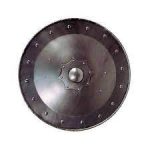
Tower Shield: Typical size is 48”x 24” Made from non-splitting wood, often with multiple layers of wood and with iron or bronze rims to make them strong. Sometimes covered in leather for extra strength and weather protection. Usually decorated. The AC Bonus from a Kite shield is -2 against THREE attacks (from front or shield side.) And 3 vs MISSILE attacks from front.
These are analogous to the Roman Scutom in size and shape. Used primarily in formations. Some have notches to push a spear or pike through..
The Tower shield is too large for small demi-human or humanoid such as a halfling or goblin to use.
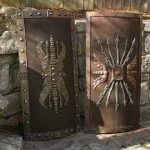
Pavise: This is a type of shield made for specialized use by crossbowmen. This type of shield is designed to be tall and wide enough to cover a crossbowmen frontally and guard him from incoming missiles while occupied loading. (50% Cover = +4 to AC to MISSILE attacks from the front while loading and shooting) The AC Bonus from a pavise in melee is -2 against THREE attacks (from front or shield side.) It also has a special feature, a hinged prop, whereby it can stand erect on its own at the battlefield. They are typically painted wood with no metal reinforcing.
Wicker Pavise: Similar in shape, size and function to a traditional pavise shield, these are made entirely of woven wicker and are very effective at stopping arrows. Their light weight and low cost means that archers and crossbowmen may carry two or three to the battle. They are useless versus an opponent in close combat and give no AC bonus.
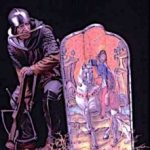
Round Shields: The most common style for shields on Titan, though size varies. Made from non-splitting wood, often with multiple layers of wood and with iron or bronze rims and boss to make them strong. Sometimes covered in leather for extra strength and weather protection. Usually decorated.
Small Round: Typical size is 18” to 24” The AC Bonus from a Small Round is -1 against TWO attacks (from front or shield side.) When a small demi-human or humanoid such as a halfling or goblin uses this shield it is treated as a Medium shield.
Medium Round: Typical size is 24” to 30” The AC Bonus from a Medium Round is -2 against TWO attacks (from front or shield side.) When a small demi-human or humanoid such as a halfling or goblin uses this shield it is treated as a Large shield.
Large Round: Typical size is 30” to 36” The AC Bonus from a Medium Round is -2 against THREE attacks (from front or shield side.) This is too large for small demi-human or humanoid such as a halfling or goblin to use.
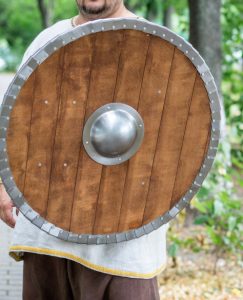
Kite Shield: Typical size is 48”x 24” Made from non-splitting wood, often with multiple layers of wood and with iron or bronze rims to make them strong. Sometimes covered in leather for extra strength and weather protection. Usually decorated. The narrow, oblong shield has multiple hand grip points so that it can be carried and used either horizontally (best for close combat) of vertically (best versus missile attacks.) The AC Bonus from a Kite shield is -2 against THREE attacks (from front or shield side.) This is too large for small demi-human or humanoid such as a halfling or goblin to use.
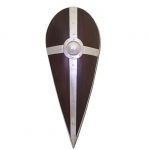
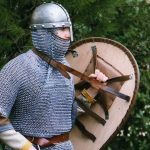
Heater: This type of shield is typically small in size, essentially a trimmed version of the kite shield. The small size of the shield makes it easier to wield it speedily on the battlefield during combat and to carry it with no discomfort. It is considered a good shield for swordsmen and for defending against sword attacks. Typical size is 18”x 24” Made from non-splitting wood, often with multiple layers of wood and with iron or bronze rims to make them strong. Sometimes covered in leather for extra strength and weather protection. Usually decorated. The AC Bonus from a Heater is -1 against TWO attacks (from front or shield side.) When a small demi-human or humanoid such as a halfling or goblin uses this shield it is treated as a Medium shield.
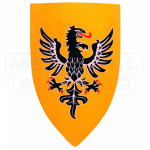
Wood & Hide Oval: Used by many tribes in Palador. These light shields are most effective vs arrows and spear thrusts. Typical size is 24” to 30” The AC Bonus is -2 against TWO attacks (from front or shield side.) 3 vs MISSILE attacks from front. When a small demi-human or humanoid such as a halfling or goblin uses this shield it is treated as a Large shield.
Wood: Simple, round shields lacking any significant metal parts. Primarily used by some non human tribes and humans in areas that lack metals or technology. Also used in training. Treat as a Small Round shield. The AC Bonus is -1 against TWO attacks (from front or shield side.)
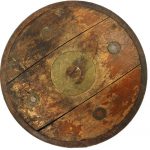
Adarga Shield: Widely used in Illshar and related areas. The adarga shield is constructed from tough leather hide, usually that of the antelope. In making the Adarga, two or more layers of the leather hide are glued together with a strong adhesive and firmly sewn together. Pieces of other kinds of leather are further used to reinforce the basic layers of the Adarga. On the inside of the shield, two leather grips are sewn with which the wearer can secure the shield to his forearm. The leather grips usually come with some kind of cushioning to further absorb the impact of blows. Metal rims and rivets are also used to further reinforce the structure of the shield. Once the basic structure of the Adarga is complete, it is extensively adorned on the exterior. Carved designs and gilded patterns were most commonly used in the decoration of the shield. The design features two overlapping ovals, looking similar to a kidney in its form. The shield is 28 to 36 inches along its longer oval axis. The AC Bonus from an Adarga is -2 against THREE attacks (from front or shield side.) This is too large for small demi-human or humanoid such as a halfling or goblin to use.
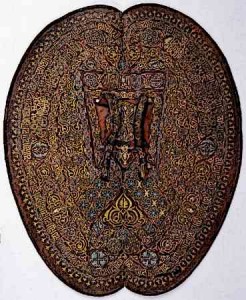
Shield Hit Points
Shields have ‘Hit Points.’ Once they take enough damage they are destroyed and must be replaced. Shields can be repaired by a skilled armorer prior to reaching zero. Repairs cost 1gp per Point restored.
Shields take 1 (one) Hit Point damage for EACH round of combat that the user DOES NOT GET HIT! A shield ONLY takes damage if it successfully did its job and blocked attacks aimed at its owner. Damage is ONLY inflicted by melee weapons. Arrows, light and medium crossbow bolts, thrown darts, daggers, rocks, hand axes, etc do not cause serious damage to a shield. (Heavy Crossbow bolts, large rocks and missiles from siege weapons such as a catapult, DO damage shields!)
An attack roll of 1 (a fumble) will not inflict damage on a defender’s shield.
An attack to subdue does not damage a shield.
As long as a shield has even 1 hit point left it still works effectively. Damage to the shield is applied at the end of the combat. A shield will not fail DURING a battle.
The resale value of captured shields is affected by the percentage of hit points that the shield still has.
Example: A PC fighter engages a Hobgoblin in melee combat. Their fight lasts 3 rounds. The hobgoblin manages three attacks vs the PC before it is slain. One attack actually hits the PC but the other two miss. The PC’s shield takes 2hp of damage from the two attacks that the shield helped deflect from the PC. These are subtracted at the end of the fight.
| Shield Type | Hit Points |
| Buckler, wood | 8 |
| Buckler, metal | 10 |
| Small Round, wood | 10 |
| Small Round, metal | 15 |
| Medium Round, wood | 20 |
| Medium Round, metal | 25 |
| Large Round, wood | 30 |
| Heater, wood | 10 |
| Heater, metal | 15 |
| Kite, wood | 25 |
| Tower, wood | 30 |
| Adarga | 25 |
| Pavise, wood | 10 |
| Pavise, wicker | 2 |
| Wood & Hide | 15 |
| Wood | 5 |
MAGIC SHIELDS do NOT wear out!
Helmets
If a helmet is not worn, 1 blow in 6 will strike at the AC 10 head, unless the opponent is intelligent, in which case 1 blow in 2 will be aimed at the AC 10 head (d6, 1-3 = head blow)
NOTE: Magic Users MAY wear Arming Caps, Arming Hoods or Leather Helms.
|
HELM TYPE |
PRICE |
NOTES |
|
Arming Cap
|
4gp |
Used in all helms or Coif |
|
Arming Hood
|
6gp |
Used in Great Helm or Coif |
|
Aventail (Camail), leather
|
1gp |
Leather curtain attached to helm to shield neck |
|
Aventail (Camail), butted
|
5gp |
Mail curtain attached to helm to shield neck |
|
Aventail (Camail), riveted |
20gp |
Mail curtain attached to helm to shield neck |
|
Aventail (Camail), welded |
100gp |
Mail curtain attached to helm to shield neck |
|
Mail coif, butted
|
10gp |
|
|
Mail coif, riveted |
40gp |
|
|
Mail coif, welded |
200gp |
|
|
Closed face helm
|
15gp |
Spangenhen Helm with face guard |
|
Great Helm
|
30gp |
Fully enclosed helm |
|
Leather Helm
|
1gp |
All leather |
|
Leather & Metal helm
|
6gp |
Leather with reinforcing bands Spangenhen type |
|
Open faced helm, metal
|
10gp |
Spangenhen Helm type |
|
Open faced helm with nose guard, metal
|
11gp |
Spangenhen Helm type |
|
Open faced helm, metal |
11gp |
‘Pot’ Helm type |
|
Open faced helm with nose guard, metal
|
12gp |
‘Pot’ Helm type |
Spangenhen Helms or ‘segmented’ helms are assembled from multiple pieces with internal reinforcements of heavier metal. The components (other then the frame) may be of leather, wood or metal. An arming cap is worn underneath. Coifs are optional.
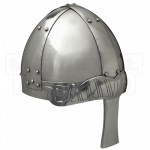
Pot Helms are shaped from a single piece of metal. An arming cap is worn underneath. Coifs are optional.
Great Helms are one piece, completely enclose the head and are lifted on and off. An arming hood is worn underneath. Coifs are optional.
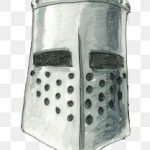
Closed Face Helms may have a movable/hinged face shield(s) or may have a ‘fixed’ partial face covering. An arming hood or cap is worn underneath. Coifs are optional.
